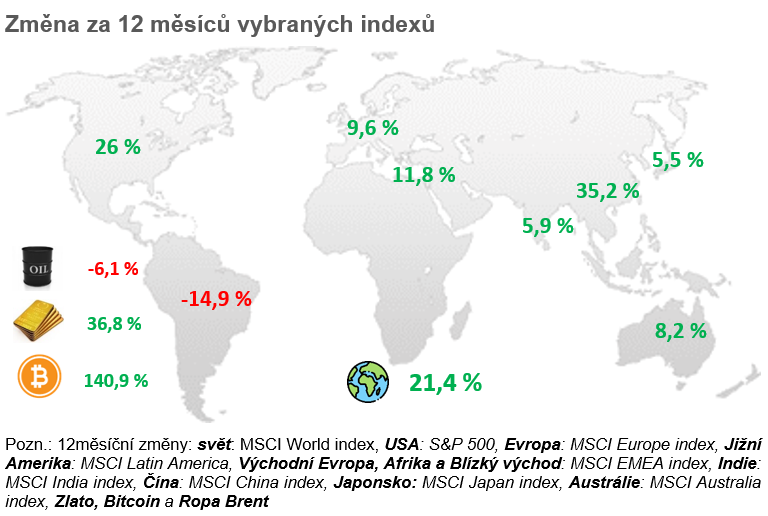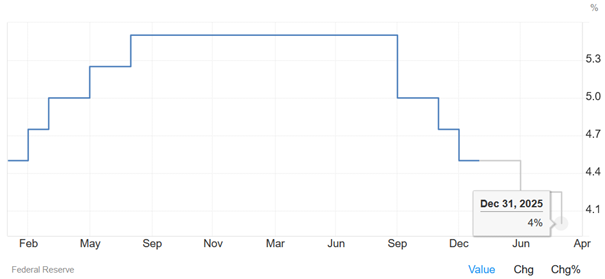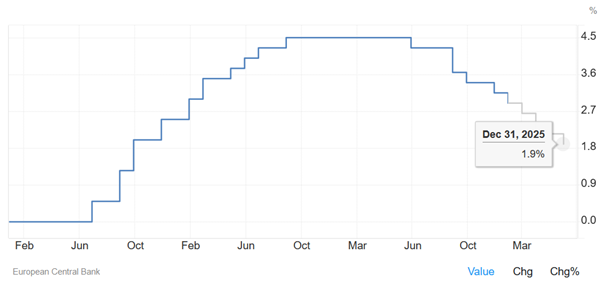Main events:
• Trade wars 2025 (lasted only a few days)
• The Fed continues to hold interest rates at 4.5%
• ECB continues to reduce down to 2.9%

Summary:
It has been only a few days since Trump’s inauguration (January 20th) and he did not wait long with his promises. The USA, for example, withdrew from the Paris Climate Agreement and on the contrary, Trump supported oil and gas extraction. The European Union thus loses a strong ally when it comes to any efforts for carbon neutrality and overall the Green Deal.
At the same time, Trump implemented stricter measures at the borders and rules for illegal migrants. He even sent a plane with illegal migrants back to Colombia, which, however, refused to accept the migrants. This started short trade wars because Trump then threatened to impose tariffs of 25% on goods imported from Colombia. The situation eventually calmed down and the parties reached an agreement.
In a similar spirit, Trump imposed tariffs on Mexico or Canada until they address the situation with illegal migrants more seriously and Mexico with drug smuggling.
Mexico eventually promised to strengthen the borders and the imposition of tariffs against Mexico and Canada was postponed for a month. The only tariffs that will likely be actually imposed and enforced are the 10% tariffs on all goods imported from China. We will have to wait for tariffs against Europe.
Besides Trump, the arrival of the Chinese artificial intelligence named DeepSeek was dealt with during January. It was developed by a Chinese startup and reportedly has results comparable to the latest models of Chat GPT, Gemini, and so on.
What was fascinating, however, was that it took only a few months to train it and at a fraction of the cost compared to Chat GPT and other models. Not even the latest chips from NVIDIA were used for it, as they are banned from being imported to China.
Initially, it seemed that the dominance of the USA in the field of AI was in jeopardy, but it is becoming more evident that it was possibly a typical Chinese report that embellished its successes.
But let’s move on to macroeconomic numbers, where the year-on-year inflation rate in the USA for December once again came out as expected at 2.9%. Behind the slight increase were both goods prices and services. For January, inflation is expected at a similar level, but in the coming months, it should again decrease to almost 2.4% level.
Unemployment for December remains at 4.1% in the USA and so far it does not signal problems in the economy.
A big topic was again the Fed meeting, which took place on January 29th, 2025. At it, the interest rates were kept at the level of 4.5%.
The year-on-year inflation rate for December in the Czech Republic came out again at an elevated level even up to 3%. The renewed increase was due to more expensive food and inflation remains close to the CNB’s tolerance band.
As for the results of year-on-year inflation in Europe, it came out for the month of December as expected at a slightly elevated level of 2.4%. However, for the coming months, its decline back to the 2% level is expected.
The ECB therefore continues to reduce interest rates, which it lowered from 3.15 to 2.9%. Unlike the Fed, it still plans to continue reducing further to 2%, which it expects for the end of 2025.
And how did other assets perform? Bitcoin, after a turbulent month, still holds above the 100,000 USD mark and gold, after a long time, has again begun to attract investors’ attention and has risen to new highs almost up to 2,900 USD per troy ounce.
Czech Republic:
The year-on-year inflation rate for December in the Czech Republic came out again at an elevated level even up to 3%. The renewed increase was due to more expensive food and inflation remains close to the CNB’s tolerance band.
Expectations regarding inflation in the Czech Republic

Source: tradingeconomics.com
For January, inflation should reach a similar result, then a slight decrease in inflation is expected and gradually until the end of the year to the 2% level. But we know predictions, they can eventually turn out anyhow.
5-year yields on Czech government bonds continue to decline and are found at the level of 3.5%. The average interest on mortgage loans currently holds slightly above the 5% mark.
USA:
The year-on-year inflation rate in the USA for December once again came out as expected at 2.9%. Behind the slight increase were both goods prices and services. For January, inflation is expected at a similar level, but in the coming months, it should again decrease to almost 2.4% level.
Unemployment for December remains at 4.1% in the USA and so far it does not signal problems in the economy.
A big topic was again the Fed meeting, which took place on January 29th, 2025. At it, the interest rates were kept at the level of 4.5%. The economy continues to develop well, but to prevent the re-ignition of inflation, a stricter monetary policy setting is still expected in the future.
Fed’s forecast regarding the reduction of interest rates in the USA

Source: tradingeconomics.com
By the end of the year, interest rates should likely be reduced only 2x by 0.25%. Not much has changed since the last December meeting.
The S&P 500 index continues its successful last year and grew by 2.77% in January.
Europe:
The year-on-year inflation rate in Europe for the month of December came out as expected at a slightly elevated level of 2.4%. However, for the coming months, its decline back to the 2% level is expected.
The ECB therefore continues to reduce interest rates, which it lowered from 3.15 to 2.9%. Unlike the Fed, it still plans to continue reducing further to 2%, which it expects for the end of 2025.
ECB’s forecast regarding the reduction of interest rates

Source: tradingeconomics.com
As a result, the euro weakened against the dollar and at one point even reached 1.02, nearing parity.
European stocks, after a long time, brought a positive return of over 6% for the month of January.
